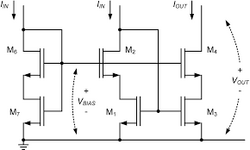sachin431
Newbie
What is the procedure for designing a very good wide swing cascode current mirror?
Im trying to design a 5uA wide swing current mirror in as in the figure. can someone please suggest a best practice to choose w/l ratio for a given technology node.
Explanation with example is appretiated. Thanks in advance.
Im trying to design a 5uA wide swing current mirror in as in the figure. can someone please suggest a best practice to choose w/l ratio for a given technology node.
Explanation with example is appretiated. Thanks in advance.
